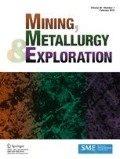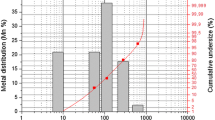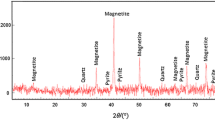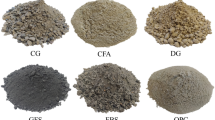Abstract
Carbon capture and storage (CCS) is an attractive area of research in such fields as CO2 mineral carbonation, global warming and sustainable energy systems. In this study, carbonation efficiency for aqueous mineral carbonation (MC) was achieved through two steps, which include leaching of calcium from cement kiln dust (CKD) followed by the reaction of pure CO2 with the calcium hydroxide precipitates formed by the hydroxylation using NaOH. Response surface methodology (RSM) with a Box-Behnken design (BBD) was applied to optimize the calcium leaching yield, while the carbonation efficiency from CKD was assessed using RSM with central composite design (CCD). Optimization of calcium leaching is highly important, as it is a rate-limiting reaction step in MC and also influences and enhances carbonation efficiency. Different parameters including acid concentration (HNO3), leaching temperature, leaching time, and dose of CKD sample were considered in order to optimize the maximum yield of Ca leaching from the CKD sample. In addition, different CO2 flow rates and temperatures were used as parameters for optimizing carbonation efficiency. Two quadratic regression models were developed for each process, i.e. calcium leaching and carbonation. For calcium leaching, a maximum of 98.55% calcium was extracted under the optimal set of acid concentration 4.13 M, 90 °C, 28 min leaching time, and 13.8 g of CKD sample. For carbonation, the maximum carbonation efficiency of 89.2% was achieved for a CO2 flow rate of 1163 cm3/min at 90 °C. Calcium leaching results indicate that the leaching yield was significantly affected by all the input parameters except leaching time. For carbonation, both factors affected the carbonation efficiency, with the effect temperature shown to be greater than that of the CO2 flow rate. Additionally, the predicted results agreed well with the experimental values for both calcium leaching and carbonation processes, with errors of less than 1% and 5%, respectively.











Similar content being viewed by others
Abbreviations
- t :
-
Reaction time, min
- T :
-
Reaction temperature, K
- ANOVA:
-
Analysis of variance
- CCS:
-
Carbon capture and storage
- MC:
-
Mineral carbonation
- IDC:
-
In direct carbonation
- CKD:
-
Cement kiln dust
- BBD:
-
Box-Behnken design
- CCD:
-
Central composite design
- RSM:
-
Response Surface Design
- FFD:
-
Fractional factorial design
- ICP–AES:
-
Inductively coupled plasma-atomic emission spectrometry
- OFAT:
-
One-factor-at-a-time
- y :
-
Predicted response
- x i :
-
Coded variables
- β o :
-
Mode constant
- βi (β1, β2, β3, β4):
-
Linear coefficients
- βii (β11, β22, β33, β44):
-
Quadratic coefficients
- βij (β12, β13, β14, β23, β24, β34):
-
Cross product coefficients
- X Ca :
-
Calcium extraction efficiency, %
- V :
-
Volume of the ligand solution used, ml
- C t :
-
Ca ion concentration analyzed at time t, hr
- m b :
-
mass of the CKD sample, g
- w Ca :
-
wt% of Ca initially present in the parent sample
- ηc :
-
Carbonation efficiency (%)
References
Azdarpour A, Asadullah M, Junin R, Mohammadian E, Hamidi H, Rafizan A, Daud M, Manan M (2015) Extraction of calcium from red gypsum for calcium carbonate production. Fuel Proc Tech 130:12–19
Matz B, Davidson O, Bosch P, Dave R, Meyer L (2007) Climate change 2007: Mitigation of climate change: contribution of working group III to the fourth assessment report of the intergovernmental panel on climate change. IPCC
Wang X, Maroto-Valer MM (2011) Dissolution of serpentine using recyclable ammonium salts for CO2 mineral carbonation. Fuel 90:1229–1237
Lackner KS, Wendt CH, Butt DP, Joyce EL, Sharp DH (1995) Carbon dioxide disposal in carbonate minerals. Energy 20:1153–1170
Bobicki ER, Liu Q, Xu Z, Zeng H (2012) Carbon capture and storage using alkaline industrial wastes. Prog Energy Comb Sci 38:302–320
Thom JGM, Dipple GM, Power IM, Harrison AL (2013) Chrysotile dissolution rates: implications for carbon sequestration. Appl Geochem 35:244–254
Eloneva S, Teir S, Salminen J, Fogelholm CJ, Zevenhoven R (2008) Steel converter slag as a raw material for precipitation of pure calcium carbonate. Ind Eng Chem Res 47:7104–7111
O’Connor WK, Dahlin DC, Rush GE, Dahlin CL, Collins WK (2002) Carbon dioxide sequestration by direct mineral carbonation: process mineralogy of feed and products. Min Metall Proc 19:95–101
Shuto D, Nagasawa H, Iizuka A, Yamasaki A (2014) A CO2 fixation process with waste cement powder via regeneration of alkali and acid by electrodialysis. RSC Adv 4:19778–19788
Eloneva S, Salminen J, Forgelholm C, Zevenhoven R (2012) Steel converter slag as a raw material for precipitation of pure calcium carbonate. Appl Energy 90:329–334
Pérez-López R, Montes-Hernandez G, Nieto JM, Renard F, Charlet L (2008) Carbonation of alkaline paper mill waste to reduce CO2 greenhouse gas emissions into the atmosphere. Appl Geochem 23:2292–2300
Katsuyama Y, Yamasaki A, Iizuka A, Fujii M, Kumagai K, Yanagisawa Y (2005) Development of a process for producing high-purity calcium carbonate(CaCO3) from waste cement using pressurized CO2. Environ Prog Sustain Energy 24:62–170
Bonenfant D, Kharoune L, Sauvé S, Hausler R, Niquette P, Mimeault M, Kharoune M (2008) CO2 sequestration potential of steel slags at ambient pressure and temperature. Ind Eng Chem Res 47:7610–7616
Chaabane L, Moussaceb K, Ait-Mokhtar A (2017) Factors affecting the leaching of heavy metals (Ni+2, Pb+2, Cr+3) contained in sludge waste stabilization/solidification by hydraulic benders, part I: water/cement and waste/cement ratio in S/S mortars. Environ Prog Sus Energy 36:93–103
Irfan MF, Usman MR, Rashid A (2018) A detailed statistical study of heterogeneous, homogeneous and nucleation models for dissolution of waste concrete sample for mineral carbonation. Energy 158:580–591
Mesci B, Coruh S, Ergun ON (2011) Use of selected industrial waste materials in concrete mixture. Environ Progress Sustain Energy 30:368–376
Wang L, Jin Y, Nie Y (2010) Investigation of accelerated and natural carbonation of MSWI fly ash with a high content of ca. J Hazard Mat 174:334–343
Jo H, Lee M-G, Park J, Jung K-D (2017) Preparation of high-purity nano-CaCO3 from steel slag. Energy 120:884–894
Jo H, Jang Y, Jo H (2012) Influence of NaCl on mineral carbonation of CO2 using cement material in aqueous solutions. Chem Eng Sci 80:232–241
Xuan D, Zhan B, Poon CS, Zheng W (2016) Carbon dioxide sequestration of concrete slurry waste and its valorisation in construction products. Const. Build. Mat. 113:664–672
Zhao Q, Liu C-J, Jiang M-F, Saxen H, Zevenhoven R (2015) Preparation of magnesium hydroxide from serpentinite by sulfuric acid leaching for CO2 mineral carbonation. Miner Eng 79:116–124
Iizuka A, Fujii M, Yamasaki A, Yanagisawa Y (2004) Development of a new CO2 sequestration process utilizing the carbonation of waste cement. Ind Eng Chem Res 43:7880–7887
Abe Y, Iizuka A, Nagasawa H, Yamasaki A, Yanagisawa Y (2013) Dissolution rates of alkaline rocks by carbonic acid: influence of solid/liquid ratio, temperature, and CO2 pressure. Chem Eng Res Des 91:933–941
Huntzinger DN, Gierke JS, Sutter LL, Kawatra SK, Eisele TC (2009) Mineral carbonation for carbon sequestration in cement kiln dust from waste piles. J. Hazard. Mat. 168:31–37
Phung QT, Maes N, Jacques D, Schutter GD, Ye G, Perko J (2016) Modelling the carbonation of cement pastes under a CO2 pressure gradient considering both diffusive and convective transport. Const Build Mat 114:333–351
Shuto D, Igarashi K, Nagasawa H, Iizuka A, Inoue M, Noguchi M, Yamasaki A (2015) CO2 fixation process with waste cement powder via regeneration of alkali and acid by electrodialysis: effect of operation conditions. Ind Eng Chem Res 54:6569–6577
Jo H, Park SH, Jang YN, Chae YC, Lee PK, Jo HY (2014) Metal extraction and indirect mineral carbonation of waste cement material using ammonium salt solutions. Chem Eng J 254:313–323
Huntzinger DN, Eatmon TD (2009) A life-cycle assessment of Portland cement manufacturing: comparing the traditional process with alternative technologies. J Clean Prod 17:668–675
Doucet FJ (2010) Effective CO2-specific sequestration capacity of steel slags and variability in their leaching behaviour in view of industrial mineral carbonation. Min Eng 23:262–269
Teir S, Eloneva S, Fogelholm C-J, Zevenhoven R (2007) Dissolution of steelmaking slags in acetic acid for precipitated calcium carbonate production. Energy 32:528–539
Bauer M, Gassen N, Stanjek H, Peiffer S (2011) Carbonation of lignite fly ash at ambient T and P in a semi-dry reaction system for CO2 sequestration. Appl Geochem 26:1502–1512
Ukwattage NL, Ranjith PG, Li X (2017) Steel making slag for mineral sequestration of carbon dioxide by accelerated carbonation. Measurement 97:15–22
Yadav S, Mehra A (2017) Experimental study of dissolution of minerals and CO2 sequestration in steel slag. Waste Manag 64:348–357
Chang EE, Pan S-Y, Chen Y-H, Chu H-W, Wang C-F, Chiang P-C (2011) CO2 sequestration by carbonation of steelmaking slags in an autoclave reactor. J. Hazard. Mat. 195:107–114
Huijgen WJ, Comans RN (2006) Carbonation of steel slag for CO2 sequestration: leaching of products and reaction mechanisms. Enviorn. Sci. Technol. 40:2790–2796
Montgomery DC (2000) Design and analysis of experiments. John Wiley & Sons, New York
Mayers RH, Montgomery DC (2002) Response surface methodology: process and product optimization using designed experiments. Wiley, New York
Irfan MF, Hossain SMZ, Khalid H, Sadaf F, Al-Thawadi S, Alshater A, Hossain MM, Razzak SA (2019) Optimization of bio-cement production from cement kiln dust using microalgae. Biotechnology Reports 23:e00356
Hossain SMZ, Sultana N, Irfan MF, Elkanzi EMA, Al-Aali YAM, Taha A, Haque SM (2016) Optimization of biodiesel production from spent palm cooking oil using fractional factorial design combined with the response surface methodology. Am J Appl Sci 13:1255–1265
Sun X, Sun Y, Yu J (2016) Sulfuric acid leaching of aluminum from activated coal spoil. Environ. Prog. Sus. Energy 35:1575–1583
Kul M, Oskay KO, Şimşir M, Sübütay H, Kirgezen H (2015) Optimization of selective leaching of Zn from electric arc furnace steelmaking dust using response surface methodology. Trans. Nonferr. Metals Soc. China 25:2753–2762
Ferdowsi A, Yoozbashizadeh H (2017) Process optimization and kinetics for leaching of cerium, lanthanum and neodymium elements from iron ore waste’s apatite by nitric acid. Trans Nonferr Metals Soc China 27:420–428
Kazeem MA, Hossain SMZ, Hossain MM, Razzak SA (2018) Application of central composite design to optimize culture conditions of Chlorella vulgaris in a batch photo-bioreactor: An efficient modeling approach. Chem Prod Process Model 20170082
Ghacham AB, Pasquier L-C, Cecchi E, Blais J-F, Mercier G (2016) CO2 sequestration by mineral carbonation of steel slags under ambient temperature: parameters influence, and optimization. Environ Sci Pollut Res. https://doi.org/10.1007/s11356-016-6926-4
Montgomery DC, Runger GC (2006) Applied Statistics and Probability for Engineers, 3rd ed. Wiley
Montgomery DC (2001) Design and analysis of experiments 5th ed. Wiley, New York
Box GEP, Hunter WG, Hunter JS (1978) Statistics for experimenters. Wiley, New York
Nabila WPN, Nasir SM, Fathullah M, Shuaib NA, Irfan AR (2019) Optimization of warpage on plastic part by using response surface methodology (RSM). AIP Conference Proceedings 2129:020197
Bezerra MA, Santelli RE, Oliveira EP, Villar LS, Escaleira LA (2008) Response surface methodology (RSM) as a tool for optimization in analytical chemistry. Talanta 76:965–977
Aslan N, Cebeci Y (2006) Application of Box–Behnken design and response surface methodology for modeling of some Turkish coals. Fuel 86:90–97
Chollom MN, Rathilal S, Swalaha FM, Bakare BF, Tetteh EK (2020) Comparison of response surface methods for the optimization of an upflow anaerobic sludge blanket for the treatment of slaughterhouse wastewater. Environmental Engineering Research 25:114–122
Joglekar AM, May AT (1987) Product excellence through design of experiments. Cereal Foods World 32:857–868
Heydarpour T, Rezai B, Gharabaghi M (2011) A kinetics study of the leaching of a calcareous phosphate rock by lactic acid. Chem Eng Res Des 89:2153–2158
Jonglertjunya W, Rattanaphan S, Tipsak P (2014) Kinetics of the dissolution of ilmenite in oxalic and sulfuric acid solutions. Asia Pac J Chem Eng 9:24–30
Azizi D, Shafaei SZ, Noaparast M, Abdollahi H (2012) Modeling and optimization of low-grade Mn bearing ore leaching using response surface methodology and central composite rotatable design. Trans Nonferr Met Soc China 22:2295–2305
Dananjayan RRT, Palanivelu Kandasamy P, Andimuthu R (2016) Direct mineral carbonation of coal fly ash for CO2 sequestration. J Clean Prod 112:4173–4182
Huijgen WJ, Witkamp G-J, Comans RN (2005) Mineral CO2 sequestration by steel slag carbonation. Enviorn Sci Technol 39:9676–9682
Acknowledgements
The authors would like to thank the Department of Chemistry and Nanotechnology Center/Central Labs at the College of Science, University of Bahrain, Kingdom of Bahrain, for allowing us to use the analytical equipment.
Author information
Authors and Affiliations
Corresponding author
Ethics declarations
Conflict of Interest
The authors declare that they have no conflict of interest.
Additional information
Publisher’s Note
Springer Nature remains neutral with regard to jurisdictional claims in published maps and institutional affiliations.
Rights and permissions
About this article
Cite this article
Irfan, M.F., Hossain, S.M.Z., Tariq, I. et al. Modeling and Optimization of Aqueous Mineral Carbonation for Cement Kiln Dust Using Response Surface Methodology Integrated with Box-Behnken and Central Composite Design Approaches. Mining, Metallurgy & Exploration 37, 1367–1383 (2020). https://doi.org/10.1007/s42461-020-00222-9
Received:
Accepted:
Published:
Issue Date:
DOI: https://doi.org/10.1007/s42461-020-00222-9




